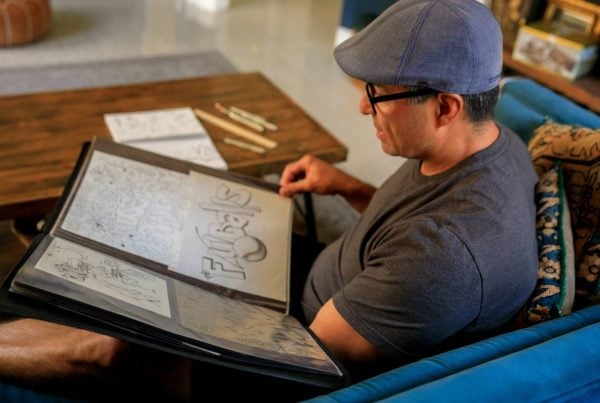Most of us have looked at a painting or photo and felt drawn to it, but may not have known why. Composition in art is the way artists arrange shapes, colours, lines, and other elements to create a balanced and interesting piece. By understanding composition, we can learn what makes artwork stand out and connect with others so deeply.
Knowing about composition helps us see the hidden structure in art. Whether we look at classic paintings or modern photos, the order and layout of elements guide our eyes and shape how we feel about what we see. If we pay attention to how these parts work together, we can appreciate art on a whole new level.
Table of Contents
Key Takeaways
- Composition is how artists arrange elements within their work.
- Good composition directs attention and shapes feeling in art.
- Understanding composition lets us better enjoy and discuss artwork.
Defining Composition in Art
Composition is essential to how we create and understand art. It guides the layout of different elements, shapes meaning, and influences the impact of any visual work.
What Is Composition?
Composition in art means carefully arranging and organising visual elements within a work. We bring together components such as line, shape, colour, texture, space, and value to form a unified whole. The way we position these elements leads a viewer’s eye and communicates our message clearly.
A strong composition does not happen by accident. Artists plan how to place objects, sometimes sketching ideas before starting the final piece. Even simple adjustments to spacing or alignment can change how the artwork feels. The arrangement of these elements determines the structure and mood of an artwork’s composition.
We use different compositional techniques, like the rule of thirds and symmetry, depending on our intent. These methods help us decide where to direct attention within the piece.
The Role of Artistic Composition
When we create art, composition acts as a guide for both creator and viewer. It shapes the narrative or emotion we want to express with our work. A well-organised composition makes complex images easier to understand and enjoy.
We use composition to add balance and focus to art. By considering the size and position of each part, we control which elements stand out. This process involves choices about contrast, movement, and hierarchy within the artwork.
The choices we make about composition can also reflect cultural or personal ideas. Through arrangement, we can evoke calm, tension, energy, or stability. Different art movements have developed their own approaches to composition, allowing each style to present unique visual experiences.
Importance in Visual Art
Composition plays a crucial role in how we experience visual art. A strong composition makes an artwork memorable and engaging, while a weak one can leave the viewer confused or uninterested. The organisation of elements helps paintings, drawings, sculptures, and photographs feel complete and meaningful.
Effective composition lets us tell stories or convey messages without words. It ensures viewers know where to look first and how to move through the scene. Good composition involves arranging elements so they express our intention, whether it’s to create harmony, focus, or drama in the piece (elements of composition in art).
Learning about composition gives us a foundation for making, interpreting, or even critiquing art. It’s a skill that applies to all forms of visual art, from traditional painting to modern digital designs.
Core Elements of Composition
When discussing composition in art, certain visual elements always form the structure of any arrangement. Understanding these helps us recognise how artists guide the viewer’s eye and create a sense of balance.
Line in Artistic Arrangement
Lines play a vital role in all compositions. They can be straight, curved, thick, thin, soft, or hard. By using lines, artists lead the viewer’s gaze across the artwork and establish structure. Lines can also suggest emotion or movement.
We often see outlines, contour lines, and implied lines. For example, a bold horizontal line can give a feeling of calm, while diagonal or jagged lines add tension or excitement. Artists use lines to separate areas, show depth, or create patterns. In some art forms, like sketching, lines alone may build up the entire picture.
Proper use of line improves clarity and focus within a composition. Without lines—either visible or suggested—other elements like shape and form lose definition. Lines are essential for both guiding viewers and organising space.
Shape and Geometric Shapes
Shape is another foundation of composition. Shapes are flat, enclosed areas created by lines, colour, or differences in texture. Shapes can be simple like circles, rectangles, and squares, or complex and organic. Geometric shapes are precise and regular, often used for strong, orderly visual effects.
We group shapes into two types:
- Geometric: Circles, triangles, squares
- Organic: Irregular, free-form, found in nature
Artists repeat shapes for patterns or overlap them to build complexity. The way shapes interact controls the balance of the composition. When shapes work together, they create unity and harmony. Overlapping and placement also help with creating the illusion of space.
Well-placed shapes can anchor a work or draw attention to a focal point. Shapes are core tools for organising the picture plane and making images recognisable.
Form and Space
Form refers to three-dimensional attributes—height, width, and depth. Unlike flat shapes, forms appear solid and can suggest mass even on a flat surface. Examples include cubes, spheres, and cylinders. Artists use shading and perspective to transform shapes into forms, giving pictures lifelike quality.
Space works closely with form. It is the area around and within objects in the artwork. There are two main types:
- Positive space: The areas taken up by actual objects
- Negative space: Empty areas in and around objects
By arranging forms and manipulating space, artists make their scenes feel spacious or crowded. Overlapping forms and using tricks like size and perspective add depth. A good balance between positive and negative space creates pleasing compositions that don’t feel too busy or empty.
Colour and Value
Colour is how we see different wavelengths of light. In art, colour can set the mood, convey emotion, or highlight certain parts of a composition. Artists work with the colour wheel, using primary, secondary, and tertiary colours.
Value is the lightness or darkness of a colour. It helps show form and depth and creates strong contrast. High value contrast can pull a viewer’s gaze or make a section pop. Low value contrast, where shades are closer together, often creates a softer effect.
We use colour schemes—combinations of colours—to create harmony or excitement. Some common colour schemes include monochromatic, complementary, and analogous. Colour and value work together to give a composition structure and mood. Without value, colour can look flat; without colour, value alone can still reveal structure and meaning.
For more detail on how these elements combine and define composition, you can find a clear summary at Rise Art.
Principles of Art and Good Composition
Achieving good composition in art relies on several key principles that help bring order, unity, and visual interest to a piece. How we balance elements, guide attention, and create movement all work together to produce an artwork that feels engaging and whole.
Balance and Harmony
Balance happens when we distribute elements across the canvas so that no part feels heavier or out of place. There are two main types: symmetrical (even on both sides) and asymmetrical (different on each side but still balanced).
Symmetrical balance often feels formal and calm, while asymmetrical balance can make the work feel more dynamic. We might use large shapes paired with several smaller shapes to keep things even. Colour and texture are also tools for balance—using a bright colour in one corner, for example, can be balanced with several more neutral shapes elsewhere.
Harmony makes sure all elements work well together rather than clash. Repeating shapes, colours, or lines helps tie the artwork together and avoids confusion for the viewer. Together, balance and harmony ensure our composition feels unified and pleasing. More about these concepts is available in this explanation of principles of composition.
Emphasis and Focal Points
Emphasis draws the viewer’s eye to the most important part of the artwork. This focal point might be created using a strong colour, dramatic contrast, or a striking shape. Placement matters, too—something placed near the centre or where lines meet will naturally attract attention.
Getting emphasis right in our composition can add meaning or create drama. We use tools like size, colour, or detail to make one element stand out. For example, a bright red apple on a table of green pears will immediately attract the gaze. A good composition uses emphasis to control how the viewer moves through the artwork and to highlight key areas.
Movement and Rhythm
Movement is how we lead the viewer’s eye from one part of the artwork to another. We achieve this by arranging shapes, lines, or colours in a way that suggests direction or flow. Diagonal lines often create a real sense of action, while curved lines can be calmer and more graceful.
Rhythm is about repetition. Just like in music, repeating shapes or colours can create a pattern that feels lively or relaxing. It gives the composition structure and keeps the eye moving. By combining movement and rhythm, we keep our artwork interesting while making sure it does not feel chaotic or confusing. Read more about these principles of composition in art.
Surface and Texture in Visual Expression
Surface and texture both play a vital role in how we experience a work of art. They shape what we see and what we feel, affecting mood and meaning through the artist’s choices.
Exploring the Picture Plane
The picture plane is the flat surface where we create an artwork, such as a canvas, paper, or wood panel. This surface sets the boundaries for the composition and how we arrange the visual elements.
We often adjust how we use the picture plane based on what effect we want to achieve. For example, using the whole area can make the artwork feel spacious, while focusing action in one spot can build tension.
Artists choose materials for the picture plane to support certain looks or techniques. A rough canvas can hold thick strokes, while smooth paper lets us draw fine, detailed lines. The surface also influences how colours and textures appear when we view the finished work.
Textural Qualities
Texture in art refers to the surface quality we can see or touch. In painting and drawing, texture is both physical (real texture you can feel) and visual (looks like something we could feel).
We may use thick paint, sand, or fabric to build actual texture. Other times, we create the illusion of texture—making a flat image appear bumpy, smooth, rough, or soft—by changing how we arrange marks and colours.
Texture helps guide the viewer’s eyes across the composition. It highlights important areas and gives depth. The choice of textural elements can make an artwork lively or quiet, rough or smooth, and help to show mood or meaning. The visual elements of line, shape, and colour often interact with texture to create rich, dynamic images.
Impact of Brushstroke and Technique
The way we use our tools—like painting with thin or thick brushstrokes, or drawing with pencils and pastels—changes the look and feel of the surface. Each brushstroke can show energy, calmness, or movement.
A painter might use fast, rough strokes to show excitement or a certain mood. Soft, careful strokes make the surface look smooth and calm. Techniques such as dry brushing or impasto affect how much paint builds up and how it catches light.
Table: Common Brushstroke Styles
| Brushstroke Type | Effect on Texture |
|---|---|
| Impasto | Thick, raised, tactile |
| Dry Brush | Scratchy, broken, rough |
| Glazing | Smooth, transparent |
| Stippling | Dotted, textured surface |
Our technique shapes both the physical surface and how viewers respond. Subtle or bold brushstrokes lead to very different feelings in a composition.
Use of Space and Negative Space
How we handle space, especially negative space, shapes how viewers experience a work of art. By placing objects and empty areas thoughtfully, we guide the eye and create visual interest.
Defining Positive and Negative Space
Positive space is where the main objects or subjects are located in a composition. Negative space is the empty or open area around and between these objects. Both types of space are important for organising a balanced and engaging artwork.
Negative space frames the main subjects and can highlight their shapes or outlines. This technique makes our compositions cleaner and less cluttered. By paying attention to both positive and negative space, we prevent the image from feeling crowded or confusing.
Artists use negative space as a background and sometimes as an active shape that interacts with the subject. This approach can lead to strong and memorable designs. For more on these definitions, the Getty Museum explains how positive and negative spaces work together in art.
Creating Depth and Perspective
We use space to create the illusion of depth on a flat surface. Overlapping objects, changes in size, and placement on the page show which items are closer or further away. Negative space often separates the objects and highlights their relationships.
Artists draw attention to certain parts of an artwork by leaving more negative space around them. Giving a subject more room can make it appear isolated or more significant. Using positive and negative space well helps us direct how a viewer’s eye travels across the image.
To add perspective, we adjust the amount of negative space between objects to make some seem near and others far. This simple use of space builds strong compositions and adds depth.
Emotion and Intensity Through Composition
How we arrange shapes, lines, and colours in a work of art guides the viewer’s feelings and holds their attention. The elements of composition can have a powerful effect on the emotion and intensity experienced by those who view our art.
Eliciting Emotional Responses
In art, composition plays a big role in how people feel when looking at a piece. If we position key subjects towards the centre, it often gives a sense of balance or calm. Moving elements off-centre or using diagonal lines brings in tension or excitement.
We use contrast—such as light against dark or rough against smooth—to draw feelings of drama, hope, or sadness. Cluttered spaces might make viewers feel overwhelmed, while open areas can suggest peace or loneliness.
Colour is important too. Warm colours like red or orange stir up energy or passion. Cooler hues, such as blue or green, may lead to relaxation or melancholy. Through careful arrangement and use of these elements, artists shape the emotional impact of their work. For more insights, see how composition in art shapes reactions.
Manipulating Intensity
Intensity in composition comes from visual interest and the choices we make in arranging elements. Strong contrasts, bold shapes, and dynamic lines add to the sense of urgency or forcefulness in an image.
We create visual interest by repeating certain shapes or colours or by directing the eye along a path through the artwork. Overlapping forms or sudden breaks in pattern make the viewer linger, searching for meaning.
Reducing detail or focusing on just a few main features can heighten intensity by making the viewer concentrate on what matters most. We manage intensity by controlling the density of objects, the use of negative space, and the rhythm set by repeating elements. Too much intensity can overwhelm, while too little leads to boredom. More on the power of composition to create a strong effect can be found here.
Cultural and Historical Perspectives
Composition in art has changed over time, shaped by different places and historical moments. Artists arrange elements in their work based on cultural traditions and new artistic ideas.
Influence of Culture on Composition
Different cultures have their own ways of arranging elements in art. In traditional Japanese art, we often see careful balance and a focus on empty space. Chinese landscape paintings use sweeping lines, balanced contrasts, and layering to suggest depth.
European religious paintings from the Middle Ages relied on symmetry and hierarchy. Artists placed important figures in the centre, using line and placement to guide the viewer’s eye. African art often uses patterns and repetition, creating rhythm and unity across a surface.
In Islamic art, geometric shapes and ordered designs show the importance of mathematics and order. These choices in composition reflect values, beliefs, and worldviews within each culture. Artists make decisions based on what their audience recognises and understands.
Compositional Shifts in Impressionists and Modern Art
With the rise of Impressionism in the late 1800s, artists started to change old rules for composition. Impressionists like Claude Monet and Edgar Degas used looser brushstrokes and off-centre subjects. They often cut off figures at the edge and captured scenes from unexpected angles.
Modern art went further, breaking away from symmetry and order. Artists like Pablo Picasso and Henri Matisse used bold shapes and unusual layouts. In Cubism, for example, we see multiple viewpoints of an object shown at once.
Abstract art moved towards total freedom. Compositions became about emotion and movement, not strict visual balance. Artists experimented with new ideas, showing that composition can change as our ways of seeing the world change. For more on shifts in composition throughout art history, see this overview of composition throughout art history.
Contemporary Approaches to Composition
Contemporary artists often break away from tradition in how they arrange elements on the canvas. Today, artists experiment with structure, visual space, and material to reflect changing ideas about art and meaning.
Trends in Abstract Painting
In recent abstract painting, artists use composition to guide our focus and emotion rather than to organise realistic scenes. Instead of clear objects, artists work with shapes, lines, and colours, arranging them to create balance or tension. We find a move towards open compositions, where forms seem to continue beyond the edges of the canvas.
Many artists break away from using a central subject. They may use repetition or patterns to create rhythm across the artwork. This approach encourages our eyes to move around the painting without settling in one spot.
Some abstract painters also favour asymmetry. By placing elements unevenly, they create motion and energy. This technique challenges our ideas about what makes a painting feel complete. For more about how artists arrange elements in art today, visit this guide on composition in art.
Modern Uses of Transparency
Transparency has grown in importance as a compositional tool. By layering colours or shapes with different levels of opacity, artists add depth and subtlety to their works. This technique can suggest movement, overlap, or the passage of time.
We notice transparency used not only in painting but also in digital media. Artists layer images or use digital effects to make parts of the artwork interact in new ways. This approach invites us to look closer and notice relationships between layers.
Overlaying transparent elements blurs boundaries between foreground and background. Artists play with visual weight, drawing or shifting our attention. Transparency in composition offers more complex visual experiences and helps artists communicate abstract ideas. If you want to learn more about composition techniques in modern art, the Tate’s definition sheds light on composition in the art world.
Frequently Asked Questions
Understanding composition in art helps us see how artists arrange elements, use different rules, and teach these concepts to all ages. Both realistic and abstract art rely on thoughtful composition, though their approaches can be quite different.
How do you define composition in the context of visual arts?
We define composition as the arrangement of visual elements within an artwork. It involves deciding where to place shapes, colours, lines, and forms on the surface. This arrangement affects how viewers experience and understand the piece visually and emotionally. For more detail, see this explanation of composition in art.
What elements constitute a strong artistic composition?
A strong composition often includes balance, contrast, unity, and emphasis. Artists use elements like line, shape, colour, texture, and space to build these qualities. Thoughtful placement of these parts helps guide the viewer’s eye and creates harmony in the artwork.
Can you describe the primary rules that govern composition in art?
There are some widely used rules, such as the rule of thirds, symmetry, and leading lines. These rules help us arrange elements in a way that feels natural and pleasing to the eye. While they are not strict requirements, they provide helpful guidelines for creating effective compositions. More information is available from Rise Art’s guide on composition.
How does composition in photography differ from that in painting or drawing?
In photography, we often work with what is already present in a scene and make quick decisions about framing and perspective. In painting or drawing, artists have more freedom to add, remove, or alter elements from their imagination. This means composition in photography tends to focus more on finding the best angle or moment, while painters and illustrators can construct scenes from scratch.
In what ways can composition in art be taught to children?
We can teach composition to children by encouraging them to experiment with arranging shapes, colours, and lines. Simple exercises, such as moving cut-out pieces on paper or making collages, help them explore balance and focus. Talking about where they place objects and why leads to a better understanding of composition.
What are some exemplary instances of composition within abstract art?
In abstract art, artists create strong compositions by carefully placing colours, shapes, and textures instead of recognisable objects. Piet Mondrian, for example, used grids and primary colours to design balanced and dynamic works. These pieces show how arrangement can give meaning and impact without realistic subjects. You can learn more by looking through examples of composition in art.








